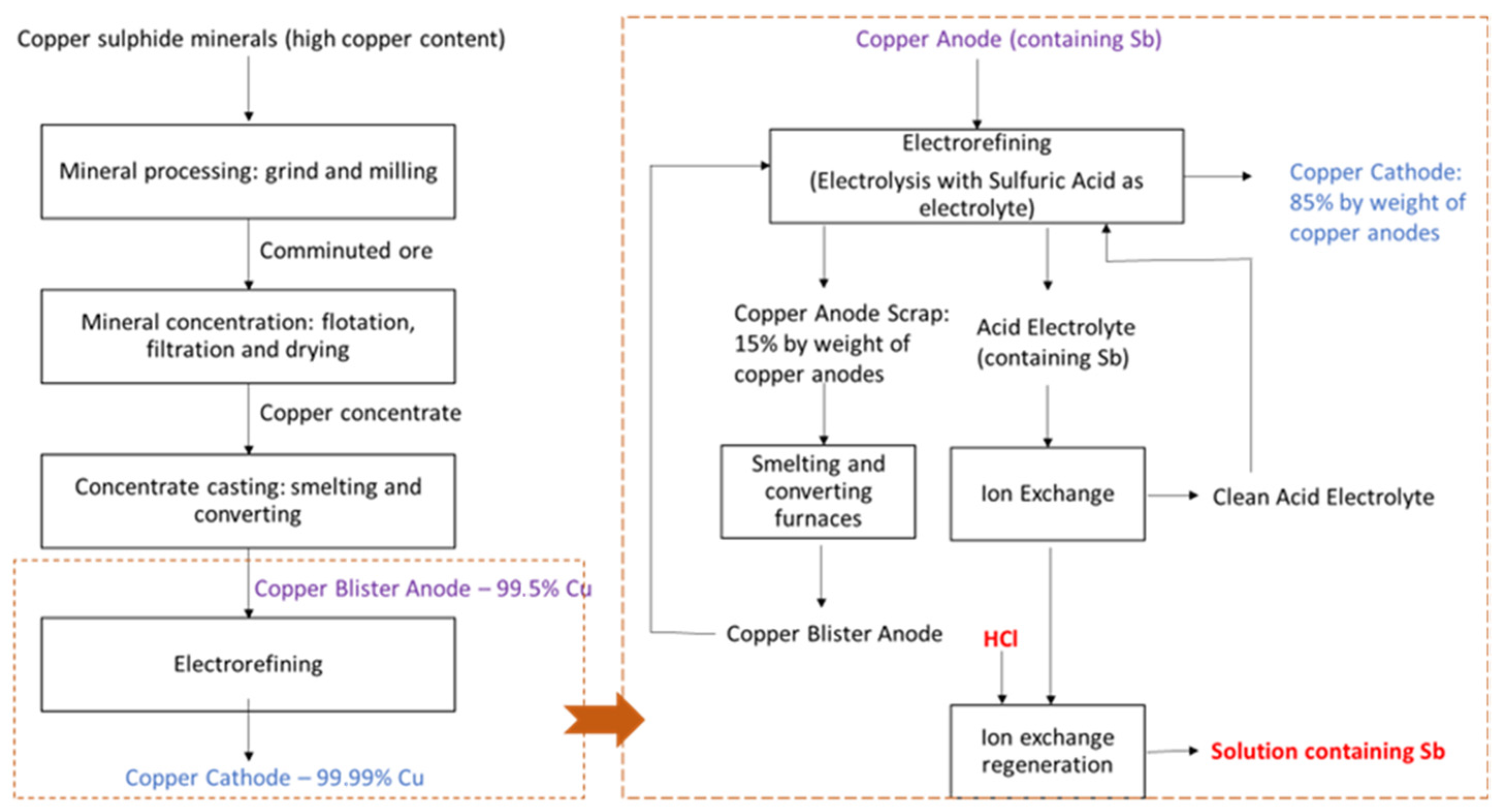Application of the Electro-Electrodialysis Technology in the Copper Mineral Processing Industry: Recovery of Antimony from Mining Tailings and Recycling of the Regenerated Solution Media †
Abstract
:1. Introduction
2. Materials and Methods
3. Results and Discussion
3.1. Cyclic Voltammograms of HCl Solutions Containing Antimony and Bismuth
3.2. Electrorecovery of Antimony and Bismuth
4. Conclusions
Author Contributions
Funding
Institutional Review Board Statement
Informed Consent Statement
Data Availability Statement
Acknowledgments
Conflicts of Interest
References
- Arroyo-Torralvo, F.; Rodríguez-Almansa, A.; Ruiz, I.; González, I.; Ríos, G.; Fernández-Pereira, C.; Vilches-Arenas, L.F. Optimizing operating conditions in an ion-exchange column treatment applied to the removal of Sb and Bi impurities from an electrolyte of a copper electro-refining plant. Hydrometallurgy 2017, 171, 285–297. [Google Scholar] [CrossRef]
- Barros, K.S.; Vielmo, V.S.; Moreno, B.G.; Riveros, G.; Cifuentes, G.; Bernardes, A.M. Chemical composition data of the main stages of copper production from sulfide minerals in Chile: A review to assist circular economy studies. Minerals 2022, 12, 250. [Google Scholar] [CrossRef]
- Hernández-Pérez, L.; Carrillo-Abad, J.; Pérez-Herranz, V.; Montañés, M.T.; Martí-Calatayud, M.C. Effluents from the copper electrorefining as a secondary source of antimony: Role of mass transfer on the recovery by electrodeposition. Desalination 2023, 549, 116322. [Google Scholar] [CrossRef]



Disclaimer/Publisher’s Note: The statements, opinions and data contained in all publications are solely those of the individual author(s) and contributor(s) and not of MDPI and/or the editor(s). MDPI and/or the editor(s) disclaim responsibility for any injury to people or property resulting from any ideas, methods, instructions or products referred to in the content. |
© 2023 by the authors. Licensee MDPI, Basel, Switzerland. This article is an open access article distributed under the terms and conditions of the Creative Commons Attribution (CC BY) license (https://creativecommons.org/licenses/by/4.0/).
Share and Cite
Martí-Calatayud, M.C.; Hernández-Pérez, L.; Bernardes, A.M.; Rodrigues, M.A.S.; Cifuentes, G.; Riveros, G.; Pérez-Herranz, V. Application of the Electro-Electrodialysis Technology in the Copper Mineral Processing Industry: Recovery of Antimony from Mining Tailings and Recycling of the Regenerated Solution Media. Mater. Proc. 2023, 15, 48. https://doi.org/10.3390/materproc2023015048
Martí-Calatayud MC, Hernández-Pérez L, Bernardes AM, Rodrigues MAS, Cifuentes G, Riveros G, Pérez-Herranz V. Application of the Electro-Electrodialysis Technology in the Copper Mineral Processing Industry: Recovery of Antimony from Mining Tailings and Recycling of the Regenerated Solution Media. Materials Proceedings. 2023; 15(1):48. https://doi.org/10.3390/materproc2023015048
Chicago/Turabian StyleMartí-Calatayud, Manuel César, Lorena Hernández-Pérez, Andréa Moura Bernardes, Marco Antônio Siqueira Rodrigues, Gerardo Cifuentes, Gabriel Riveros, and Valentín Pérez-Herranz. 2023. "Application of the Electro-Electrodialysis Technology in the Copper Mineral Processing Industry: Recovery of Antimony from Mining Tailings and Recycling of the Regenerated Solution Media" Materials Proceedings 15, no. 1: 48. https://doi.org/10.3390/materproc2023015048
APA StyleMartí-Calatayud, M. C., Hernández-Pérez, L., Bernardes, A. M., Rodrigues, M. A. S., Cifuentes, G., Riveros, G., & Pérez-Herranz, V. (2023). Application of the Electro-Electrodialysis Technology in the Copper Mineral Processing Industry: Recovery of Antimony from Mining Tailings and Recycling of the Regenerated Solution Media. Materials Proceedings, 15(1), 48. https://doi.org/10.3390/materproc2023015048








